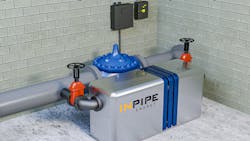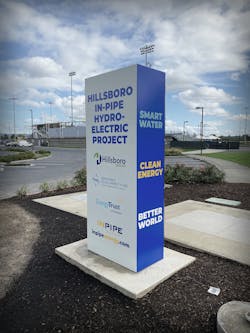Turning Pressure into Energy and Dollars
Managing water can be a high-pressure job — in every sense of the word. Water agencies are grappling with aging infrastructure, water loss, declining revenues, and rising operational costs. Energy is typically the second largest expense for water utilities, accounting for up to 40 percent of the agency’s budget. And the COVID-19 pandemic has added even more pressure, both operationally and financially.
But there is relief in sight. Through smart pressure management in water pipelines, water agencies can help alleviate some of these other pressures as well by turning a waste stream into a revenue stream.
For the City of Hillsboro (Ore.) Water Department, precise pressure management is essential to efficient water management, reducing non-revenue water, extending the life of infrastructure, and keeping customers happy. Hillsboro is a high-tech industrial city of 100,000 residents located in the heart of Oregon’s “silicon forest.” Most of the city’s water comes from the nearby Tualatin River. It’s treated and then pumped up to reservoirs at elevation for delivery to homes and businesses. The pumping process is energy- intensive and always at the mercy of rising energy prices, but there’s also untapped energy embedded in all that gravity-fed water.
“We’re always looking for ways to more efficiently deliver water to our ratepayers, but finding the most practical and cost-effective levers is key,” Eric Hielema, water department engineering manager for the City of Hillsboro, said. “So, when we learned about a new solution coming out of research done at Oregon State University that addresses both pressure management and energy, we were immediately interested.”
That research was funded by InPipe Energy for its In-PRV, a new product that combines smart pressure control with micro-hydro technologies to meet the challenges facing many water departments.
“We typically use PRVs to reduce the pressure for delivery to homes and businesses, but with a traditional PRV, all of that kinetic energy is not used to its full potential,” Hielema said. “The In-PRV functions as a PRV, but what excites me about it is that it converts that excess pressure into electricity we can then use to power our infrastructure.”
The City of Hillsboro purchased the In-PRV in February 2020 and commissioned it in October 2020 at the Gordon Faber Recreation Complex. It is the first renewable energy project featuring the In-PRV. The system manages pressure for Hillsboro Water while generating up to 200,000 kWh of electricity per year that is fed back into the grid, offsetting the city’s cost of energy and helping to power the lights, concessions, and charging fleets at EV charging stations at the stadium complex.
This single In-PRV generates enough electricity to power 20 homes, which amounts to about a million dollars’ worth of electricity over the life of the project. The City of Hillsboro expects payback on its investment within three years, but the return on this investment is more than financial. The system is also helping the city meet its climate action goals by reducing more than 162,000 pounds of carbon annually. That equates to over 240,000 driven miles off the road every year.
“The In-PRV provides a practical way for us to capture energy that’s already in our system, and we’re using it to reduce our operating costs, which benefits the ratepayers and helps us be more sustainable and resilient,” Hielema said. “It’s a very efficient solution because it fits into our existing system without requiring us to change how we currently operate and without adding burdensome maintenance activities.”
The In-PRV is designed for easy, low-impact installation and is located in a bypass where it provides redundancy to an existing valve. The In-PRV’s sensors and software are integrated into the SCADA system, allowing Hillsboro Water to monitor pressure, flow and electricity production 24/7. This, combined with the system’s ability to manage pressure at both high and low flows, helps the city more efficiently manage its water operations while helping preserve the life of its infrastructure.
Conduit, or in-pipe, hydropower has been used in a few large-scale projects around the country, including the LucidPipe Power System installed in a water pipeline in the nearby city of Portland. Gregg Semler, InPipe Energy’s founder, is the former CEO of Lucid Energy, which developed the Portland system.
“As I met with water managers across the country, I realized there was an opportunity to generate a new source of renewable energy from existing water infrastructure, but installing the system in such large-scale projects was often impractical and caused too much disruption to water operations,” Semler said. “Water agencies liked the idea of something that would monetize excess pressure but wouldn’t disrupt their operations. So, we set out to create a turnkey product that can be installed quickly, easily, and cost-effectively throughout water systems with smaller-diameter pipelines.”
Semler and his team spent four years developing, prototyping and validating the In-PRV, working with Oregon State University’s Mechanical, Industrial, and Manufacturing Engineering department to develop the technology. The Hillsboro installation is the first in a city water pipeline, and several other In-PRV installations are slated in the coming year in Oregon, Washington, Texas, Utah and California.
“As a water utility, in order to stay cost-effective for ratepayers, we have to make sustainable, long-term investments that look forward 50 years instead of 20 years,” Hielema said. “With the In-PRV we can generate electricity from a resource that is otherwise wasted.”
The In-PRV can be installed wherever there are water systems that use pressure reducing valves in 12” to 42” pipelines. It is located in a bypass around a PRV, making it easy to install onto an existing or new pipeline with minimal impact on water operations. A sensor continuously monitors flow and pressure. As water flow is diverted through the In-PRV, a micro-hydro turbine and generator combined with a sophisticated control valve, reduces pressure to the precise level required by the water utility, and the excess pressure is converted into electricity that can be used on site or fed to the grid for net-metering. Grid connection is similar to solar systems.
The system’s precision pressure management eliminates chatter, vibration and pressure pulses that can lead to leaks and water loss, which helps extend the life of infrastructure. It provides redundancy for existing valves and gives water managers precise control over pipeline pressure during both high and low flows, something older PRVs don’t provide with as much resolution. The dashboard provides real-time, continuous data on flow, upstream/downstream pressure and energy production, which are all significant tools to provide water loss control.
“Water is the most important resource on the planet, but water agencies everywhere are struggling with aging infrastructure and rising costs,” Semler said. “The City of Hillsboro took a risk most water agencies are reluctant to do: to be first to try a new technology. But they are committed to being a leader in pressure management and to minimize unanticipated water loss events. With this project up and running, they are helping other water utilities with similar challenges discover a new way to better manage pressure, extend the life of their infrastructure and produce carbon-free, renewable energy that benefits their bottom line and their rate payers.” WW
About the Author: Jennifer Allen Newton is president of Bluehouse Consulting Group Inc. She is a consultant and writer covering issues related to water, energy, health and environment. Email her at [email protected].
About the Author
Jennifer Allen Newton
Jennifer Allen Newton is president of Bluehouse Consulting Group, Inc. She is a consultant and writer covering issues related to water, energy, health and environment. Email her at [email protected].


